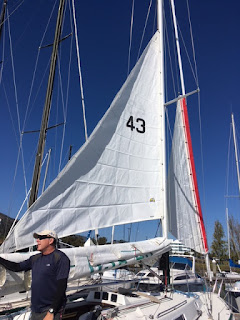Of course, once you've made that decision the hard part is deciding where to put the solar panel(s) and how to mount them. You want to avoid shading on the panel and it needs to be out of the way, further limiting your choices. We've decided to put the panel on the stern pulpit, but it needed to be able to be moved out of the way should we need to access the emergency rudder system. Using rail mounts on a stainless steel tube across the stern pulpit seemed the way to go. We first tried this using hose clamps to mount the tube, but that didn't prevent the tube from rotating due to the weight of the solar panel. So we opted for jaw clamps commonly used for dodger frames:
These are relatively inexpensive, easy to remove, and hold everything securely. The panel is a Solara 140 watt Ultra Series with SunPower cells (22.5% efficient!).
With the rail clamps we can rotate the panel for best sun exposure and we can rotate it down out of the way if we need to get to the transom.
Need to clean up the wiring to the deck plug and get a more robust, better waterproof deck plug.
Added a Victron MPPT 75/15 charge controller, it's in the starboard locker directly below the panel. Then it's just a short run up the wire chase on the port side of the engine to the house batteries. Also added the little blue tooth dongle that allows me to monitor the solar panel output on my smart phone. Pretty cool.
Of course, December isn't the best time to test a solar setup. Later in the spring we'll get everything running and make sure the power plan works as anticipated.





































